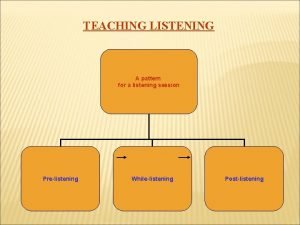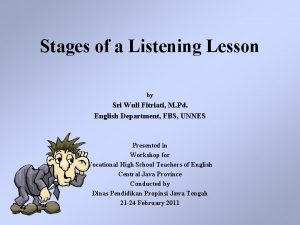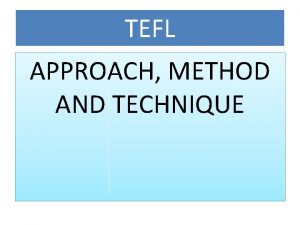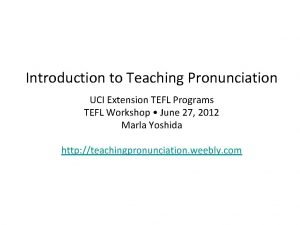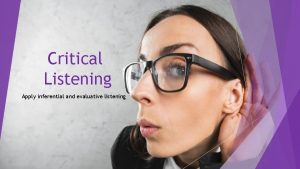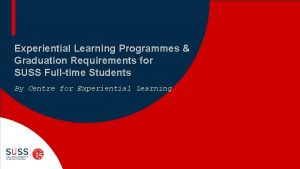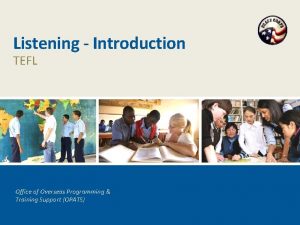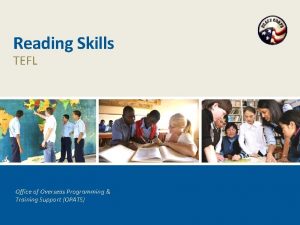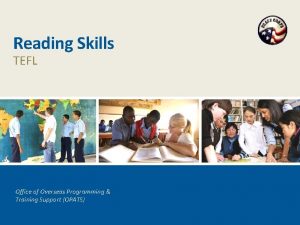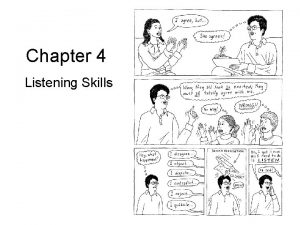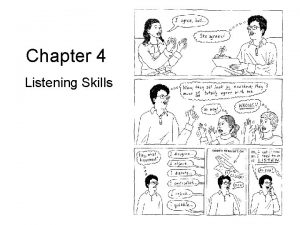Listening Introduction TEFL Office of Overseas Programming Training

















- Slides: 17

Listening - Introduction TEFL Office of Overseas Programming & Training Support (OPATS)

AS A NATIVE ENGLISH SPEAKER YOU HAVE IMMEDIATE VALUE. YOU CAN. . . pick up a text and immediately make it a listening passage. You can repeat a listening passage, or a part of it as often as necessary without starting, stopping rewinding, or recuing. . . You can model native speaker rhythm, stress, linking, reductions and words You can easily think of comprehension questions about the passage you’ve just read.

WHAT ARE SOME WAYS YOU CAN BRING LISTENING PRACTICE INTO ANY ENGLISH CLASS? What are your ideas? Put them on a flip chart, please! Did you think of— 1. Presenting all dialogues, stories, directions, etc. as LISTENING COMPREHENSION ACTIVITIES first 2. Making English the procedural language in class 3. Paying attention to chunks of language 4. Practicing until automatic spoken expressions that support listening? “What was that again, please? ”

QUICKLY, LET’S LOOK AT EXAMPLES OF STRATEGY 4: ASKING FOR REPETITION EXAMPLES Could you please repeat? I’m sorry, I didn’t get that. I’m sorry, I didn’t quite hear you. Excuse me, what was that again? I’m sorry, I still didn’t understand. Could you go over that again? I want to make sure I got it.

CONFIRMING (FROM BOTH DIRECTIONS) CONFIRMING YOU UNDERSTOOD Okay, I got it. I understand. Okay, you want me to…/I’m supposed to…(repeat message). CONFIRMING OTHERS HAVE UNDERSTOOD YOU Was that clear? Did you understand? Should I go over that again?

ASKING FOR CLARIFICATION EXAMPLES— Could you go over that again? Okay, tell me about the part where… (refer to topic). Could we go through that one more time? Did you say… (repeat what you thought you heard)? Now, what am I supposed to do first?

HOW DO WE LISTEN? Do we work hard to listening to every word? If we get lost while listening and can’t interrupt, how do we “pick up the thread” of what we are listening to? weeeeeee Ho ver Why are making assumptions about context and predictions important to successful listening?

SO IF YOUR PREDICTION GOES WRONG IN LISTENING, WHAT CAN YOU DO TO REGROUP? In conversation, you simply ask for repetition or clarification. However, in oral presentations, requests for repetition are often not possible. Well, since we can’t go back and see where our prediction went wrong, we can only listen for the next transition word/logical connector (therefore, however) which will point us in the direction the presentation is going.

HOW IS LISTENING IN CONVERSATIONS DIFFERENT FROM ORAL PRESENTATIONS? What can we use beside pure listening skill to understand in conversations? What are some aspects of conversation that make it more difficult to comprehend what is being said? How are oral presentations different from listening to conversation? Why are they both important? What should this tell us about designing classroom listening activities?

WHY IS LISTENING A THRESHOLD SKILL FOR OVERALL ENGLISH PARTICIPATION? If you’re a beginner in a foreign language, can you keep up in a real conversation? Even if you’re advanced how well do you keep up at a cocktail party where everyone else is a native speaker? If you can only listen word by word (and you struggle to do that), can you participate in conversations? So how can we help beginners begin “participating in English” as soon as possible?

THRESHOLDS OF LISTENING PROFICIENCY Listening proficiency has several listening thresholds: The ability to— 1. understand competent English users when they are speaking attentively to an English learner. 2. understand conventional conversation about general topics 3. understand less conventional conversation, often on specific topics—when speakers aren’t taking special care to be sure that they’re understood.

MORE ON THRESHOLDS OF LISTENING PROFICIENCY: BEING ABLE TO UNDERSTAND Face-to-face conversation about conventional topics Face-to-face conversation on a diverse topics Movies or television programs Non face-to-face conversation (phone calls) Radio (or other audio only) presentations As is the case with most language development, progress through initial levels may happen relatively quickly, but, progress between higher levels typically takes more and more time.

PDP PRE Listening, DURING Listening, POST Listening An approach to designing listening activities and lessons

PRE LISTENING ACTIVITIES INCLUDE: Can you think of some PRE Listening activities? Activating student background knowledge (asking them questions, or sharing a personal experience, or relating to other classroom lessons the topic of the listening passage) Showing pictures related to the listening passage Doing an impromptu role play with a student that “reveals” the listening content (for a listening passage on food ask a student to pretend s/he is at a restaurant and is going to order her/his favorite meal and that you are the waiter). Pre-teaching a few key vocabulary items or phrases that are probably new to the students

HOW ABOUT DURING ACTIVITIES? DURING activities include: repeating the listening passage more than once emphasizing particularly useful “chunks” of language through stressed intonation or questions, checking comprehension and clarifying vocabulary and the context of the passage probing implications of passage. discussing the author’s purpose or style making connections with other readings, lessons, or student real-life experiences

HOW ABOUT POST ACTIVITIES? POST activities include: reviewing other vocabulary/chunks not the teacher has not yet covered discussion of topic of the listening activity developing student comprehension by asking both lower order and higher order questions applying the information in the passage to solving a problem or carrying out a process. using the listening passage as a model for the students to then make a personalized version/alternative to the passage they heard.

NOW, YOU’RE ON YOUR OWN! In groups design your own, original listening activity with appropriate PRE, DURING, and POST elements.
 What is post listening stage
What is post listening stage Stages of a listening lesson
Stages of a listening lesson American international school rome
American international school rome Approach method and technique in tefl
Approach method and technique in tefl Tefl denmark
Tefl denmark Uci tefl
Uci tefl Active vs passive listener
Active vs passive listener Inferential listening meaning
Inferential listening meaning Monash abroad email
Monash abroad email Lesson 1: europeans explore overseas
Lesson 1: europeans explore overseas Overseas chinese population
Overseas chinese population Zip trading
Zip trading Cdc jobs overseas
Cdc jobs overseas Ktk overseas ag
Ktk overseas ag Overseas private investment corp
Overseas private investment corp Lesson 1 europeans explore overseas
Lesson 1 europeans explore overseas Lesson 1 europeans explore overseas
Lesson 1 europeans explore overseas Suss head heart habit
Suss head heart habit
